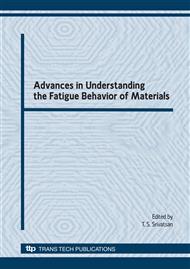p.3
p.17
p.29
p.39
p.53
p.65
p.81
p.101
High Cycle Fatigue Behavior of Normalized 0.15% C Steel under Tension-Compression and Torsion Loading
Abstract:
Fatigue properties of mild steel are investigated under cyclic tension-compression and cyclic torsion loading using ultrasonic fatigue testing equipment and cycling frequency of approx. 20 kHz. Both S-N curves show a distinct change of slope at about 107 cycles, and endurance limits determined at 107 and 109 cycles differ by less than their respective standard deviations. Endurance limit shear stress determined for cyclic torsion loading is about 60% of the tension-compression endurance limit stress, and the slopes of the S-N curves are comparable. Non-propagating cracks could be found in specimens, which did not fail within 109 cycles in torsion loading endurance tests. The endurance limit can be understood as maximum stress amplitude, where possibly formed small cracks do not propagate to failure.
Info:
Periodical:
Pages:
29-38
Citation:
Online since:
March 2008
Price:
Сopyright:
© 2008 Trans Tech Publications Ltd. All Rights Reserved
Share:
Citation:


